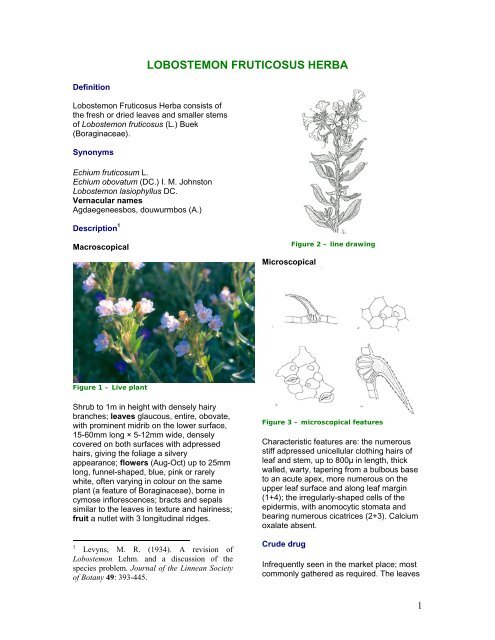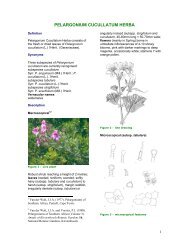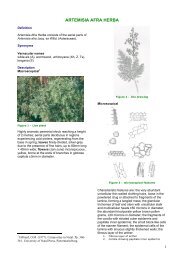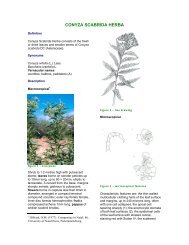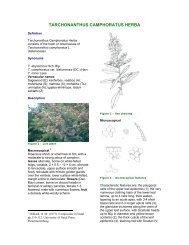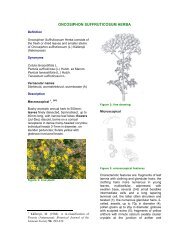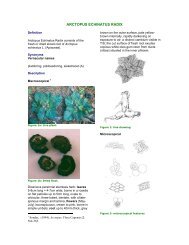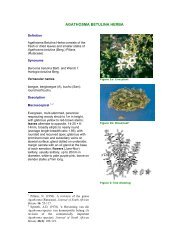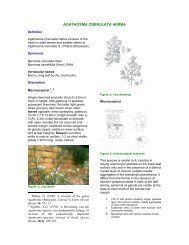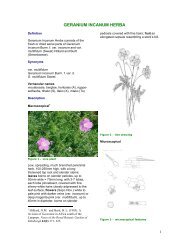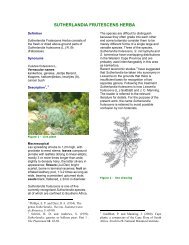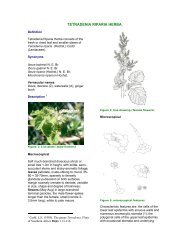LOBOSTEMON FRUTICOSUS HERBA - PlantZAfrica
LOBOSTEMON FRUTICOSUS HERBA - PlantZAfrica
LOBOSTEMON FRUTICOSUS HERBA - PlantZAfrica
Create successful ePaper yourself
Turn your PDF publications into a flip-book with our unique Google optimized e-Paper software.
Definition<br />
<strong>LOBOSTEMON</strong> <strong>FRUTICOSUS</strong> <strong>HERBA</strong><br />
Lobostemon Fruticosus Herba consists of<br />
the fresh or dried leaves and smaller stems<br />
of Lobostemon fruticosus (L.) Buek<br />
(Boraginaceae).<br />
Synonyms<br />
Echium fruticosum L.<br />
Echium obovatum (DC.) I. M. Johnston<br />
Lobostemon lasiophyllus DC.<br />
Vernacular names<br />
Agdaegeneesbos, douwurmbos (A.)<br />
Description 1<br />
Macroscopical<br />
Figure 1 – Live plant<br />
Shrub to 1m in height with densely hairy<br />
branches; leaves glaucous, entire, obovate,<br />
with prominent midrib on the lower surface,<br />
15-60mm long × 5-12mm wide, densely<br />
covered on both surfaces with adpressed<br />
hairs, giving the foliage a silvery<br />
appearance; flowers (Aug-Oct) up to 25mm<br />
long, funnel-shaped, blue, pink or rarely<br />
white, often varying in colour on the same<br />
plant (a feature of Boraginaceae), borne in<br />
cymose inflorescences; bracts and sepals<br />
similar to the leaves in texture and hairiness;<br />
fruit a nutlet with 3 longitudinal ridges.<br />
1 Levyns, M. R. (1934). A revision of<br />
Lobostemon Lehm. and a discussion of the<br />
species problem. Journal of the Linnean Society<br />
of Botany 49: 393-445.<br />
Microscopical<br />
Figure 2 – line drawing<br />
Figure 3 – microscopical features<br />
Characteristic features are: the numerous<br />
stiff adpressed unicellular clothing hairs of<br />
leaf and stem, up to 800µ in length, thick<br />
walled, warty, tapering from a bulbous base<br />
to an acute apex, more numerous on the<br />
upper leaf surface and along leaf margin<br />
(1+4); the irregularly-shaped cells of the<br />
epidermis, with anomocytic stomata and<br />
bearing numerous cicatrices (2+3). Calcium<br />
oxalate absent.<br />
Crude drug<br />
Infrequently seen in the market place; most<br />
commonly gathered as required. The leaves<br />
1
have a blue-green colour and a roughleathery,<br />
slightly succulent texture, with no<br />
perceptible odour.<br />
Geographical distribution<br />
Figure 4 – distribution map<br />
Almost confined to the Western Cape<br />
Province, on sandy slopes and flats from<br />
Namaqualand to Uniondale.<br />
Quality standards<br />
Identity tests<br />
Thin layer chromatography on silica gel<br />
using as solvent a mixture of toluene:diethyl<br />
ether:1.75M acetic acid (1:1:1). Reference<br />
compound cineole (0,1% in chloroform).<br />
Method according to Appendix 2a.<br />
Rf values of major compounds: 0.51 (greypurple);<br />
0.58 (grey-purple); 0.65 (leaf green);<br />
0.72 (sage green); cineole: 0.83 (blue-grey)<br />
Figure 5 – TLC plate<br />
HPLC on C18 column, method according to<br />
Appendix 2b.<br />
Figure 6 a – MeOH HPLC spectrum<br />
Figure 6 b – DCM HPLC spectrum<br />
Major compounds:<br />
Methanol extract: (figure 6a)<br />
Retention times (mins): 19.78; 20.40; 21.91<br />
DCM extract: (figure 6b)<br />
Retention times (mins): 6.55; 8.11; 8.72;<br />
9.58; 10.31; 11.00<br />
Ethanol (70%) soluble extractive value:<br />
not less than 14% (range variable: 13.92-<br />
25.43%)<br />
Purity tests<br />
Assay<br />
Not yet available<br />
Major chemical constituents<br />
Figure 7 – chemical constituents<br />
2
Little is known of the chemistry of this<br />
species, or of others in this South African<br />
endemic genus. The family is characterised<br />
by the presence of naphthoquinone<br />
derivatives, pyrrolizidine alkaloids, cyclitols,<br />
phenolic acids, tannins and the ureide<br />
allantoin 2 (figure 7), the latter compound<br />
being particularly abundant in the root of<br />
comfrey, (Symphytum officinale). Chemical<br />
tests in our laboratories indicated the<br />
presence in Lobostemon fruticosus of<br />
tannins, saponins and reducing sugars, but<br />
not of alkaloids nor of cardiac or cyanogenic<br />
glycosides. Polysaccharides appear to be<br />
present, as aqueous infusions are very<br />
viscous and set to a gel if in sufficient<br />
concentration.<br />
Dosage forms<br />
Fresh material, sweated in a pan with<br />
vegetable oil or butter, is applied to the skin<br />
as a dressing or ointment. An aqueous<br />
infusion is taken orally.<br />
Medicinal uses<br />
Preparations of this herb, either alone or in<br />
combination with Melianthus major, M.<br />
comosus and Galenia africana, are<br />
commonly applied externally to treat<br />
wounds, sores, ringworm, erysipelas,<br />
eczema or other dermatological disorders 3 .<br />
Aqueous infusions are recorded as being<br />
taken orally to treat gynaecological<br />
complaints.<br />
Several species in the family, namely<br />
hound’s tongue (Cynoglossum officinale),<br />
borage (Borago officinale) and lungwort<br />
(Pulmonaria officinale), were formerly official<br />
in various pharmacopoeias and used mainly<br />
as emollients or demulcents.<br />
Pharmacology/bioactivity<br />
The results of assays for antimicrobial<br />
activity carried out in our laboratories did not<br />
suggest in vitro activity against<br />
Staphylococcus aureus, Pseudomonas<br />
aeruginosa, Candida albicans or<br />
Mycobacterium smegmatis. No other<br />
scientific studies of the bioactivity of this<br />
herb appear to have been made.<br />
2 GR 9<br />
3 GR 1, 20, 22, 24.<br />
Contraindications<br />
There are no reports of contraindications to<br />
the external use of this herb.<br />
Adverse reactions<br />
Although preliminary chemical tests do not<br />
indicate the presence of alkaloids in L.<br />
fruticosus, the occurrence of hepatotoxic<br />
pyrrolizidine alkaloids in some genera of the<br />
family suggests that oral preparations of this<br />
herb should be used with caution and for a<br />
limited period only (no more than two<br />
weeks). Prolonged oral use of comfrey and<br />
other pyrrolizidine containing herbal<br />
medicines e.g. coltsfoot, has been<br />
discouraged because of the cumulative<br />
nature of these toxins.<br />
Precautions<br />
No special precautions<br />
Dosage<br />
To be determined.<br />
Copyright in this monograph resides with the authors, the South<br />
African National Biodiversity Institute, the South African Medical<br />
Research Council and the University of the Western Cape. It may<br />
not be reproduced in whole or in part without the written consent of<br />
the copyright holders.<br />
3


